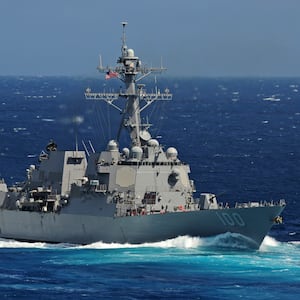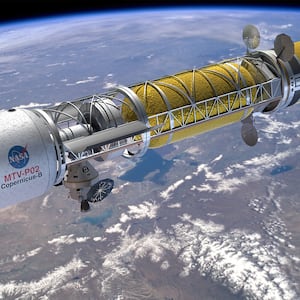There’s a huge blank space in the U.S. military’s long-anticipated report on recent UFO sightings. It’s one we need to fill before we can even start making sense of the 144 sightings of mysterious flying objects the feds have registered since 2004.
We need data from the Federal Aviation Authority. The FAA’s logs, drawing on countless sweeps by thousands of air traffic control radars over a span of two decades, could help the Pentagon to create a “baseline” for UFO activity across North America.
The agency’s records could help the military figure out just how unusual its own UFO sightings are. It’s possible the armed forces—the Navy, in particular—have attracted weirdly high numbers of what the feds call “unidentified aerial phenomena.” On the other hand, it’s possible these phenomena are all over the place.
Determining whether UFOs are zeroing in on the military could help us steer toward a better understanding of what exactly these weird flying things actually are.
The current UFO hype started back in 2004, when a Navy radar operator directed the crew of an F/A-18 fighter toward a mysterious object that appeared to be hovering 20,000 feet over the Pacific Ocean a hundred miles off the California coast.
As Cmdr. David Fravor and Lt. Cmdr. Jim Slaight closed within visual range of the UFO, they were startled by what they saw.
It appeared to be an aircraft of some sort. Oval in shape. Around 40 feet long. It hovered over the water, churning up waves and foam. Fravor steered his fighter directly at the object. Abruptly the UFO sped away, Fravor told The New York Times. “It accelerated like nothing I’ve ever seen.”
“I have no idea what I saw,” he added. “It had no plumes, wings or rotors and outran our F-18s.”
In the following 17 years, Navy crews logged another 143 UFO sightings, according to the brief, inconclusive report that the Office of the Director of National Intelligence released on Friday.
“Most of the UAP [unidentified aerial phenomena] reported probably do represent physical objects given that a majority of UAP were registered across multiple sensors, to include radar, infrared, electro-optical, weapon seekers and visual observation,” the report noted.
But the task force’s analysts declined to say with any certainty what kind of physical objects the UAPs might be. The possible categories include “airborne clutter, natural atmospheric phenomena, [U.S. government] or U.S. industry developmental programs, foreign adversary systems and a catchall ‘other’ bin.”
If you’re wondering where extraterrestrials are lurking in the UFO report, it’s there in the “other bin.” The task force’s analysts went to great lengths to avoid saying what everyone is thinking—that whatever has been buzzing the Navy’s ships and planes these last 17 years maybe came from outer space.
We’re a long way from saying for sure whether the UFOs are aliens or, say, high-tech spy drones belonging to Russia or China. There’s not a lot of scientific rigor in the Navy’s procedures for reporting mysterious flying objects, the task force noted. “Limited data and inconsistency in reporting are key challenges.”
Right now the Navy is the only federal agency we know of that’s been filing official UFO reports. That creates what the task force called a “collection bias.” That bias makes it seem like the U.S. fleet is attracting mysterious flying objects like an outdoor light attracts bugs.
It’s possible UFOs really are drawn to the Navy. If a repeatable, verifiable scientific process can confirm that’s the case, then we could logically assume—although not say for sure—that the UFOs might be foreign spy drones. After all, the Russians and Chinese have a clear motive for, and long history of, buzzing the U.S. fleet for intelligence-gathering purposes.
It seems less logical that alien visitors would concentrate their attention on Navy training exercises. That said, it might not be fair to apply human logic to extraterrestrial thinking, John Rummel, a scientist with the California-based SETI Institute, which analyzes space signals for evidence of alien communication, told The Daily Beast.
We should open our minds to “aliens doing alien things for reasons that we would never espouse ourselves,” Rummel said.
Before we can say whether the Navy really is getting more than its fair share of attention from UFOs, we need to know whether UFOs are showing up “when U.S. forces are not present,” the task force explained.
We need “a way to baseline ‘standard’ UAP activity,” the task force added.
Data baselines are a key control in scientific studies—and they’re critical to military operations, as well. The Navy itself spent decades building up a baseline for ocean noise in order to help it hunt enemy submarines. If you know what the sea sounds like when a submarine isn’t present, then you know what sounds might indicate a sub is passing through.
The FAA is key to creating that baseline, the task force explained. “The FAA captures data related to UAP during the normal course of managing air traffic operations. The FAA generally ingests this data when pilots and other air-space users report unusual or unexpected events to the FAA’s Air Traffic Organization.”
The FAA did not respond to a request for comment.
The task force’s analysts “feel like they'd get a much broader picture of U.S. air space if they coordinated with the FAA,” Wade Roush, a science lecturer and author of Extraterrestrials, told The Daily Beast. “Which—if you want to do a more serious study—is a no-brainer.”
“The more data you have, the more material there would be for a machine-learning approach to sifting through the data,” Roush added. The feds could create a computerized system that ingests standardized UFO reports and spits out initial assessments: dismissing the dismissible sightings; highlighting the sightings that warrant further study.
Creating this system is easier said than done, of course. “Collection of a baseline system is just a wise acknowledgement that the hard parts of using such data are ahead of us,” Rummel said.
The Pentagon has already started getting FAA data, according to the report. It’s not clear when, or how, the military plans to relay that data to the public—although it’s worth noting that the June report is described as just a “preliminary assessment.”
As long as public interest endures, more official UFO reports are probably coming. The next one might start to plug in that vital FAA data and give us a better sense of just how many UFOs are a normal number of UFOs.










